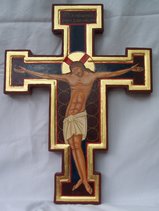 It's not often I find myself in the vanguard of business innovation, so I was really pleased to hear a discussion about the popularity and success of buying art over the web on BBC Radio 4 this morning. I started selling paintings from my website back in 2009 - I think this little crucifix (now somewhere on Orkney) was one of the first commissions I received by internet. I have always been surprised and delighted that people are prepared to buy something so personal as an artwork 'sight unseen'; though the ability to email a high resolution photographic scan is really helpful, and I haven't yet had a buyer ask to return a painting. And my experience is mirrored higher up the feeding chain - apparently on line sales of art have been increasing across the board, even in the four and five figure bracket, and with giants such as Sothebys and Christies. This is a wonderful thing for artists because, provided one can get to grips with the intricacies of on line marketing, it opens the world up for sales and liberates us from selling solely through brick-and-mortar galleries. People are always shocked to hear that an art gallery generally takes 50% of the sale price of a piece, plus VAT on top of that. In London that fee would often be 60% or 70%. Rent and rates on high street premises, glossy brochures and travelling to art fairs and functions all costs a great deal of money even before the gallery's staff costs are paid. It is very hard for a gallery owner to make a living. Unfortunately it is even harder for an artist. To make more than five pence an hour painting an original, an artist's work must command a very good price indeed, involving years spent slowly building a 'name' and nudging up ones prices. A gallery's commission is only the start of the expenses involved in selling. The artist bears the cost of professional framing - if you have ever had a print framed, you will know how expensive that can be. A gallery takes work 'on consignment' - that is to say, the artist is paid nothing for it until it sells, if at all. Often an artist has to pay an up-front annual fee for wall space before the gallery will actively market the work. As a result, many galleries are stocked largely with prints or cheerful-looking canvasses with rorschach blobs and splashes. So dear reader, if you are buying art for your home and want something really original and unique I urge you to become a patron of the arts. Hunt down the artist's website and approach them directly. No prices displayed? It costs nothing to ask! |
The view from my deskCurrent work, places and events, art travel, and interesting snippets about Christian icons, medieval art, manuscript illumination, egg tempera,, gilding, technique and materials. Categories
All
Archives
January 2024
|

 RSS Feed
RSS Feed